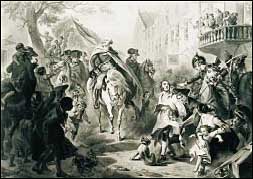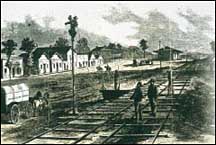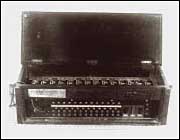
Espionage, counterintelligence,
and covert action have been important tools of US political leaders since
the founding of the Republic. During the Revolutionary War, General George
Washington and patriots such as Benjamin Franklin and John Jay directed
a broad range of clandestine operations that helped the colonies win independence.
They ran networks of agents and double agents, employed deceptions against
the British army, launched sabotage operations and paramilitary raids,
used codes and ciphers, and disseminated propaganda and disinformation
to influence foreign governments. America's founders all agreed with General
Washington that "the necessity of procuring good intelligence is
apparent and need not be further urged....[U]pon Secrecy, Success depends
in Most Enterprizes...and for want of it, they are generally defeated..."

George Washington was a master user
of intelligence.
Presidents in the early republic were actively involved in intelligence activities--especially covert actions. In his first State of the Union message, Washington requested that Congress establish a "secret service fund" for clandestine activities. Within two years, the fund represented over ten percent of the federal budget. Thomas Jefferson drew on it to finance the United State's first covert attempt to topple a foreign government, one of the Barbary Pirate states, in 1804-05. (It failed.) James Madison employed agents of influence and clandestine paramilitary forces in trying to acquire territory in the Florida region from Spain during 1810-12. Several presidents dispatched undercover agents on espionage missions overseas. One spy, disguised as a Turk, obtained a copy of a treaty between the Ottoman Empire and France. Also during this period, Congress first tried to exercise oversight of the secret fund, but President James K. Polk rebuffed the lawmakers, saying, "The experience of every nation on earth has demonstrated that emergencies may arise in which it becomes absolutely necessary ... to make expenditures, the very object of which would be defeated by publicity."
In the Civil War both Union and Confederacy extensively engaged in clandestine activities. They acquired intelligence from clandestine agents, military scouts, captured documents, intercepted mail, decoded telegrams, newspapers, and interrogations of prisoners and deserters. Neither side had a formal, high-level military intelligence service. The North's principal spymasters were Allen Pinkerton and Lafayette Baker--who both proved most effective at counterespionage--and military officers George Sharpe and Grenville Dodge. The Confederacy had a loose array of secret services that collected intelligence and conducted sabotage and other covert actions. Three of the South's most celebrated agents were women--Rose Greenhow, Belle Boyd, and Antonia Ford. In 1864, Confederate operatives tried to organize antiwar elements in Indiana, Illinois, and Ohio into a secession movement, and set a rash of fires in New York City in an attempt to burn it down. Northern and Southern agents in Europe engaged in propaganda and secret commercial activities. Overall, the North was more effective at espionage and counterintelligence, while the South had more success at covert action. The hardwon expertise and organization built up during the Civil War was soon demobilized and dispersed.

Both the Union and Confederacy
intercepted and decoded telegrams
during the Civil War.
The United States' first formal, permanent intelligence organizations were formed in the 1880s: the Office of Naval Intelligence and the Army's Military Intelligence Division. They posted attachés in several major European cities principally for open-source collection. When the Spanish-American War broke out in 1898, the attachés switched to espionage. They created informant rings and ran reconnaissance operations to learn about Spanish military intentions and capabilities--most importantly, the location of the Spanish Navy. One US military officer used well-placed sources he had recruited in the Western Union telegraph office in Havana to intercept communications between Madrid and Spanish commanders in Cuba. The US Secret Service--in charge of domestic counterintelligence during the war--broke up a Spanish spy ring based in Montreal that planned to infiltrate the US Army.
When World War I started in 1914, the United States' ability to collect foreign intelligence had shrunk drastically because of budget cuts and bureaucratic reorganizations. The State Department began smallscale operations against the Central Powers in 1916, but not until the United States declared war on Germany in 1917 did Army and Navy intelligence receive infusions of personnel and money-too late to increase their intelligence output correspondingly. The most significant advance for US intelligence during the war was the establishment of a permanent communications intelligence agency in the Army-the forerunner of the National Security Agency. Meanwhile, the Secret Service and military counterintelligence aggressively interdicted numerous German covert actions inside the United States that included psychological warfare, political and economic operations, and dozens of acts of sabotage against British-owned firms and factories supplying munitions to Britain and Russia. The Justice Department's Bureau of Investigation (forerunner of the FBI) took on a counterintelligence role in 1916, and Congress passed the first federal espionage law in 1917.
Between the wars, American intelligence officers concentrated on codebreaking and counterintelligence operations against Germany and Japan. Notwithstanding Secretary of State Henry Stimson's alleged dictum that "gentlemen do not read each other's mail," by 1941, the United States had built a worldclass signals intelligence capability. The "Black Chamber" under Herbert Yardley, the Army's Signal Intelligence Service under William Friedman, and Navy cryptanalysts cracked Tokyo's diplomatic encryption systems. Working backward from intercepts, Friedman's team figured out what kind of cipher device the Japanese used-the "Purple" machine. During the 1930s, the FBI launched an extremely effective counterintelligence attack on German and Japanese espionage and sabotage operations in the Western Hemisphere, infiltrating many networks and arresting dozens of agents. The Bureau had less success against Soviet efforts to penetrate US governmental and economic institutions.

American cryptanalysts cracked
Japan's "Purple" machine in 1941.
As American entry into World War II seemed to draw closer in 1941, President Franklin Roosevelt created the country's first peacetime, civilian intelligence agency--the Office of the Coordinator of Information--to organize the activities of several agencies. Soon after, however, the United States suffered its most costly intelligence disaster ever when the Japanese bombed Pearl Harbor. That failure-a result of analytical misconceptions, collection gaps, bureaucratic confusion, and careful Japanese denial and deception measures-led to the establishment of a larger and more diversified intelligence agency in 1942, the Office of Strategic Services.